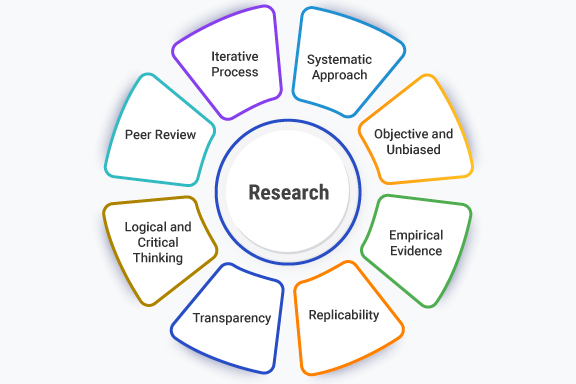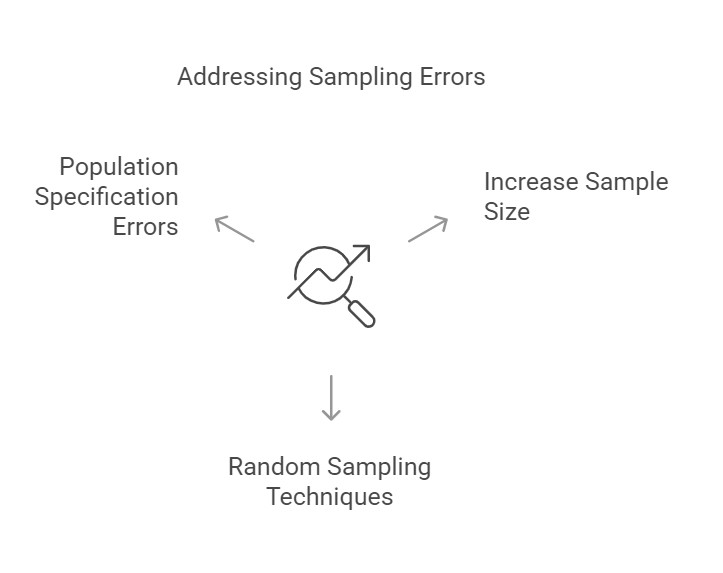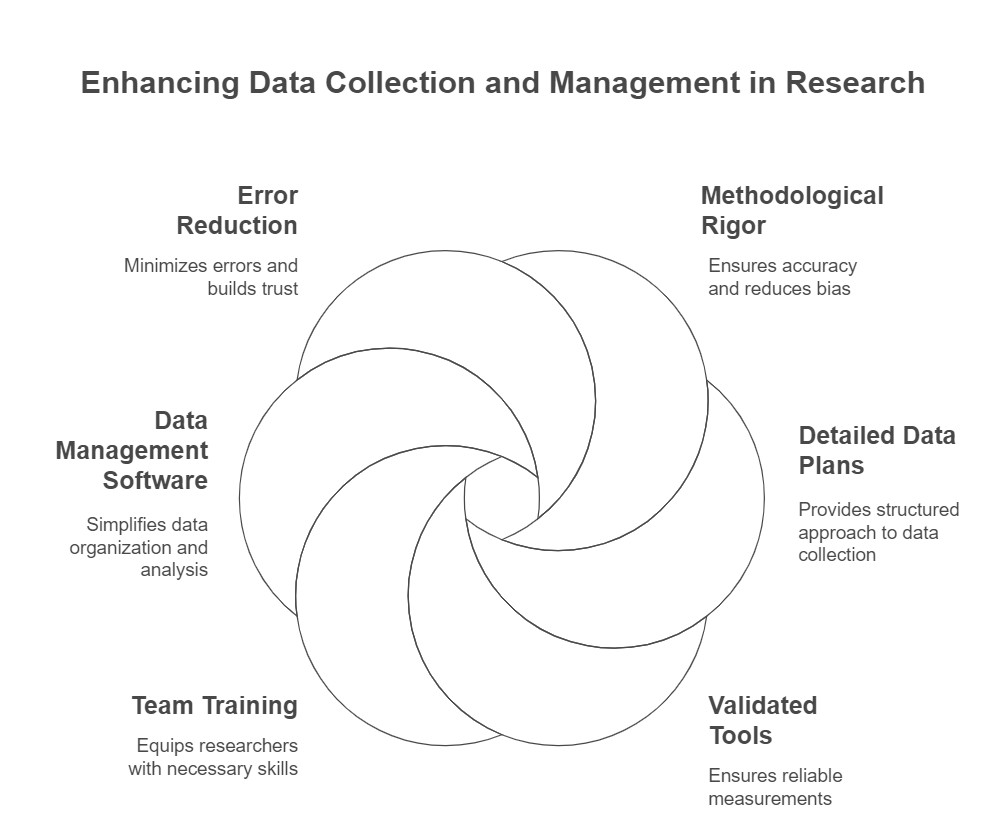- Research platform
Sources of information
Data analysis
Actions
- Solutions
For whom
Problems / Issues
- Materials
Materials
- About us
About us

The research and research process are vital in every study. Many people make errors that affect their results, especially during the phase where they collect data. The person conducting the research must ensure accuracy and quality during data collection and maintain communication with statistical analysts. This post will discuss the seven frequent mistakes found in the research process. It aims to help you spot and prevent issues that may harm your results. Students, professionals, and others interested in research practices find this information useful.
Common errors include wrong sampling methods and weak research design. Data collection matters, and how you manage that data is key. There are also ethical issues every researcher should keep in mind. We will point out these missteps to help improve your research abilities. This helps in carrying out correct and ethical studies. Stay with us as we explore these issues and show you how navigate successfully through the research and research process.
In the research and research process, many mistakes can impact results. A key error is not having a clear research goal. If researchers lack a specific target, they may gather unnecessary data. This leads to confusion. A defined goal helps shape the research design and the formation of hypotheses.
Another mistake is using a poor methodology. Researchers may choose methods that don’t match their questions or objectives. This mismatch leads to findings that lack reliability. For example, using qualitative methods on quantitative questions can produce unsuitable data. This reduces relevance and trustworthiness of the research. Inadequate statistical methods compromise the quality and interpretability of quantitative research, thereby undermining the overall validity of experiments.
Additionally, failing to review existing literature before new research can result in repeating studies. Understanding current knowledge helps identify gaps that must be filled. This prevents redundant efforts and allows researchers to place their findings in the right context.
The impact of these errors can be serious. They can damage the integrity of the research process. Unclear goals or incorrect methods waste time and resources. They can also mislead stakeholders who depend on findings for decisions. Badly designed studies may have results that don’t replicate, hurting trust in research.
Staying aware of these common mistakes aids researchers in improving their work. By setting clear research goals, choosing the right methods and thoroughly reviewing existing studies, researchers can enhance the validity of findings. This can lead to more reliable outcomes. It is also crucial to seek feedback from peers and mentors to refine manuscripts and ensure clarity in how the work contributes to the existing body of literature.
Going forward, it’s vital to see how sampling strategies can cause research errors. This will become clear in the next part on sampling errors.
Research planning errors can significantly impact the success of a research project. One common mistake is failing to clearly define the research problem or question, which leads to a lack of focus and direction. Without a well-defined problem statement, researchers may collect irrelevant data, resulting in confusion and wasted resources.
Another critical error is not conducting a comprehensive literature review. This oversight can lead to a lack of understanding of existing research and missed opportunities to identify gaps in knowledge. A thorough literature review helps researchers build on previous studies and avoid redundant efforts.
Additionally, researchers often neglect to develop a detailed research design, including a plan for data collection and analysis. This can lead to inaccurate data and flawed conclusions. A robust research design ensures that the research methods align with the research question and that the data collected is reliable and valid.
To avoid these errors, researchers should take the time to carefully plan their research project. This includes defining the research problem, conducting a thorough literature review, and developing a detailed research design. By doing so, they can enhance the quality and reliability of their research outcomes.
A comprehensive literature review is a cornerstone of any successful research project. It involves a thorough examination of existing research on a particular topic, including key findings, methodologies, and limitations of previous studies. This process helps researchers identify gaps in knowledge, develop a deeper understanding of the research topic, and inform the development of their research design.
To conduct a comprehensive literature review, researchers should use a variety of sources, such as academic journals, books, and conference proceedings. Employing a systematic approach to searching for and evaluating the literature is crucial. This includes using relevant keywords, databases, and citation tracking to ensure a thorough and unbiased review.
By conducting a comprehensive literature review, researchers can ensure that their research project is well-informed and builds on existing knowledge in the field. This not only enhances the credibility of their work but also contributes to the advancement of the research area.

Sampling errors happen when a research sample isn’t like the whole population. This difference can hurt the reliability of research results. It may lead to misleading conclusions. For example, a small sample that’s not random might display the views of a narrow group. This doesn’t show the wide range of opinions in the larger population.
A good example of sampling errors shows in past polling data. In the 1948 U.S. presidential election, most polls suggested Thomas Dewey would win against Harry Truman. But the polls mainly sampled likely voters. This did not show the real voting population, causing a famous misprediction.
To lower sampling errors, researchers can use some strategies. One way is to increase the sample size. Bigger samples often provide a better picture of the population’s traits. Also, using random sampling techniques can help get diversity within the sample. This lowers bias and improves the accuracy of findings.
Figuring out and fixing sampling errors is key in the research and research process. Having samples reflect the target population helps researchers boost the validity of conclusions and the overall impact of studies.
As we continue to explore the detail of the research and research process, considering population specification errors is also necessary. These errors come when researchers do not clearly define the population they study. This can worsen problems that begin with sampling errors.
Follow-up surveys are also crucial in addressing non-responsive errors. They help ensure greater participation and reduce bias by reaching respondents who may not have replied initially, thereby enhancing the overall quality and completeness of survey data.
In the research and research process, defining the target population is key. Population specification errors happen when a researcher does not properly identify the relevant population for their study. This misalignment leads to data that does not reflect the actual characteristics or opinions of the intended group.
For example, a study meant to evaluate consumer preferences among millennials, if wrongly includes respondents from a wider age range. In such a case, the findings may mislead insights. The consequence of these errors is significant; they produce skewed results.
The demographics of participants must match the target population. Otherwise, the research outcomes may result in erroneous conclusions. These can misguide decisions based on untrustworthy data. Such issues undermine the validity of research findings.
To prevent population specification errors, researchers need to outline problem statements clearly at the study's beginning. By precisely defining the target population, researchers can align their methods with the desired sample characteristics. This requires thorough research on the population, using sampling techniques that reflect the needed demographics.
Additionally, researchers must continuously validate these parameters as taken throughout the research process. For instance, incorrect population targeting may cause a situation where 40% of survey respondents don't fit the target demographic. These discrepancies show the need for careful population specification before data collection.
Ensuring proper targeting allows research to provide actionable insights rather than irrelevant information. Understanding population specification errors is crucial in research and research process phases, especially while designing studies. Poor research design often follows misunderstandings about populations and will be discussed in the next section.
In the context of research projects and the research process, a strong design is crucial. Poor design can stop valid and reliable results. A well-structured research design is the base for properly approaching the research question. It also makes sure that findings are accurate and trustworthy.
Common research design flaws include unclear objectives, bad sampling methods, and incomplete data collection strategies. These problems lead to various issues that result in unreliable outcomes. For instance, if objectives are vague, the research can go off track. It may address wrong issues or collect unhelpful data. A careless sampling could create a sample that does not represent the whole population. This skews results and can weaken the research conclusions.
A checklist can help author prevent these issues. Good practices include having clarity in research objectives, using proper sampling methods, setting strict data collection protocols, and doing pilot studies. Testing methodologies before the complete research helps. By sticking to these rules, researchers can boost the quality of their work. They can create findings that are useful and trustworthy.
Moving on from well-structured design, the next area of concern in research and research process is non-responsive errors. Such errors make the research process more complex and affect the outcomes.
Questionnaire and survey design issues can significantly impact the quality of data collected in a research study. One common mistake is failing to pilot test the questionnaire or survey. Without pilot testing, researchers may end up with unclear or ambiguous questions that do not accurately capture the desired information.
Another error is not using a systematic approach to developing the questionnaire or survey. This includes using clear and concise language, logical question ordering, and appropriate response formats. A well-structured questionnaire ensures that participants understand the questions and provide accurate responses.
Additionally, researchers must consider the potential biases and limitations of self-report data. Self-report data can be prone to inaccuracies due to social desirability bias or recall errors. To mitigate these issues, researchers should design questions that minimize bias and consider using multiple data collection methods.
To avoid these errors, researchers should take the time to carefully design and pilot test their questionnaire or survey. Using a systematic approach ensures that the data collected is accurate and reliable, leading to more valid and trustworthy research findings.
Non-responsive errors arise during the research and research process when people do not fill out surveys or skip questions. This error can significantly distort the data and reduce the validity of findings. It is concerning since it may cause participation bias. This causes a group of respondents not to represent the larger population.
Non-responses impact data integrity deeply. When many participants do not respond, results can be unrepresentative. Researchers may then reach conclusions that are inaccurate for the overall population. This undercuts the quality of insights gained from data. It affects the trustworthiness of any advice based on those findings.
To lower the chance of non-responsive errors, several actions can be taken. An effective survey design matters. Good surveys have clear and short questions that help engage participants. Clear design can increase survey completion rates. Also, researchers can send reminder notifications. This action may raise response rates, making the sample more accurate. Providing rewards for filling surveys can likewise make participation better.
In summary, it is important to address non-responsive errors effectively. This approach helps protect the data's accuracy collected. It also improves the research and research process overall. Careful thought about designing surveys and managing participants helps in gathering reliable insights. Such effort leads successful results in research activities.

Data collection and management are crucial for research and research process. They ensure that the outcomes of studies are valid and reliable. Researchers face many challenges when collecting data. Such challenges can distort results and affect conclusions drawn from research. This reveals how important it is to use appropriate methods during data collection.
Methodological rigor helps determine how accurate data is. Over 30 percent of studies encounter bias due to weak data collection. Researchers need to follow strict protocols to prevent inconsistencies. It is necessary to maintain data integrity in the research process.
To improve data collection and management, high-level strategies should be applied. These include making detailed data plans, using validated tools for measurements, and training team members involved in the research process. Also, it is helpful to use data management software which simplifies the organization and analysis of collected data.
A strong data collection framework reduces errors. It also builds trust in research findings. As the research process becomes more complex, effective data management becomes increasingly important. Accurate data management is the foundation for reliable conclusions.
Recognizing the value of data collection and management leads to the next focus: research ethics and communication. This area further influences how integrity is maintained within the research process.
In research, ethics are crucial. Ethical issues can derail the research process. This can lead to results that are invalid and harmful. Data fabrication, falsification, and plagiarism are common ethical pitfalls. Addressing ethical issues is essential. Serious breaches can harm the researcher's reputation and damage trust in scientific inquiry.
Additionally, poor communication in research dissemination is a key issue. When researchers do not communicate well, their findings lose impact. This can spread misinformation. Clear communication bridges the gap. When the public and stakeholders understand research, it helps make informed decisions. If a study misrepresents its implications, it can cause misconceptions that affect public health.
To maintain ethical integrity and improve communication, researchers must adopt best practices. Using ethics review boards during the research design is important. Informed consent must be ensured. Transparency throughout the research process is essential. Researchers should also focus on clarity in writing. Using layman's terms helps make complex findings understandable for a wider audience. This dedication to ethics and clear communication enhances the research process. It also increases the relevance of research in real-world contexts.
In conclusion, understanding and avoiding common errors in the research and research process can enhance quality and reliability significantly. We discussed sampling errors, population mistakes, and poor design, with data collection's importance. Ethics and communication matter greatly for strong research outcomes.
Now, you need to put this knowledge in action! Check your research strategies and ensure you can tackle these pitfalls. Acknowledge errors and work to avoid them to improve your research. You will also increase its impact and usefulness.
Keep in mind, the research and research process are powerful tools when executed right. Embrace these concepts and elevate your research work. Your commitment to better practices today will lead to richer, reliable outcomes tomorrow!
Copyright © 2023. YourCX. All rights reserved — Design by Proformat